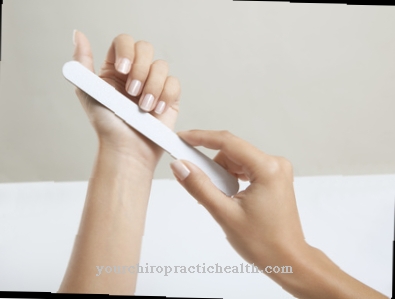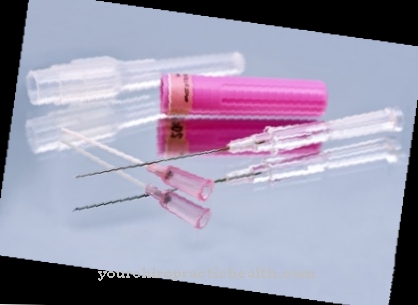A Denture adhesive serves to improve the hold of a dental prosthesis. Tried and tested adhesives are adhesive creams, adhesive gels, adhesive strips or adhesive powder.
What is a denture adhesive?

Denture adhesives are special adhesives that ensure the firm hold of dentures.If a prosthesis is inadequately fastened, there is a risk that it will loosen up when eating or speaking. Such a process occurs primarily with full dentures. Partial dentures, on the other hand, have fixed anchors such as clips or attachments.
In the upper jaw, the fixed position of a denture is usually not a problem. Fastening difficulties can occur in the lower jaw, however, because the tongue and masticatory muscles move in lever. If there are unfavorable jaw conditions, which are usually caused by a shrinkage of the alveolar process, a prosthesis adhesive is used.
The use of a prosthesis adhesive is particularly necessary with older prosthesis wearers because they no longer have sufficiently viscous saliva due to the decline in saliva production. But a prosthesis adhesive can also be useful for new prostheses so that the familiarization phase is easier for the wearer.
Shapes, types & types
There are different types of denture adhesives that can give the denture a firm hold. Most of the remedies are adhesive creams. They are offered both with and without zinc. The zinc has an anti-inflammatory effect. In addition, the essential trace element can promote wound healing and relieve pain.
By using an adhesive cream, the denture is not stuck to the jaw, but adheres well to it, even if the amount of saliva is no longer sufficient for a natural hold. A film is created on the basis of the prosthesis, which increases the adhesion (attachment force). In addition, cavities that may be present in the jaw are also filled. This applies to adhesive creams as well as other denture adhesives such as adhesive gel, adhesive strips, adhesive pads or adhesive powder. In drugstores and pharmacies, the adhesives are mostly offered in the form of liquids or ointments.
The adhesive cushions were a popular variant. These are foils made of stretchable plastic. The warmth of the body makes the material softer and hugs you. After being sucked onto the jaw, the adhesive pads can stick to it for up to three weeks. When the prosthesis is cleaned on a daily basis, the adhesive pad will stick to it. The constituents of the adhesive cushion include polypropylene laurate, methacrylate, iron oxide pigment, titanium dioxide and polybutylene.
Another type of prosthesis adhesive is the adhesive strip. It is composed of fine fleece fabric with sodium alginate. The adhesive strips have the shape of a dental prosthesis and can be shaped for both the upper jaw and the lower jaw. When they are used, they are placed on the moistened prosthesis.
Structure & functionality
The exact composition of denture adhesives is not exactly known because manufacturers are reluctant to provide relevant information. Depending on which adhesive is used, it can be sodium alginate, methyl cellulose, carboxymethyl cellulose, or a mixture of calcium-sodium salts from maleic anhydride and methyl vinyl ether. Other possible ingredients are aloe vera, petroleum jelly, menthol, zinc, cellobiose, azorubine, paraffin and silicon dioxide.
Methyl cellulose is one of the most common active ingredients. Prosthetic adhesives that contain this substance have an immediate effect and have a long-term effect. A basic requirement for the positive effect of a denture adhesive is a well-fitting denture, because defects in the denture cannot be compensated for by the adhesive. If a suitable denture is available, the adhesive ensures the thickening of the mucus, which becomes more tougher. This causes the prosthesis to stick. Before insertion, the owner of the denture cleans the dentures outside of the oral cavity.
Adhesive powder is considered useful for an upper jaw prosthesis, while an adhesive cream is more suitable for a lower jaw prosthesis. To apply, the user applies four pea-sized amounts to the prosthesis. Then he inserts the dentures into his mouth and presses it firmly on until it sticks. Then it is important to let some time pass before eating and speaking.
We do not recommend using too much denture adhesive, as this will reduce the adhesive effect. The removal of the adhesive from the prosthesis should be done every day for reasons of hygiene.
You can find your medication here
➔ Medicines against tartar and tooth discolorationMedical & health benefits
The use of a prosthesis adhesive gives the prosthesis wearer several advantages. The adhesives ensure a better fit and a comfortable feeling for the dentures. For example, the movements of the dental prosthesis are reduced, which in turn counteracts unpleasant pressure points. At the same time, the gums are cushioned, which gives the user a better wearing comfort. Since the prosthesis adhesive increases the hold of the prosthesis, the user of the denture can bite harder. Furthermore, the edge of the dental prosthesis is also sealed by the adhesive. In this way, food scraps can be avoided.
With the help of a denture adhesive, the wearer of the third teeth feels safer and more confident. So he can eat, talk and laugh without fear. According to the results of numerous public studies, denture adhesives actually improve the hold of dentures, provided they are properly seated. Even the irritation or pressure points that the prostheses cause can be reduced by the adhesive.
The use of denture adhesives is considered harmless to health. However, it is important to remove the breeding ground for harmful germs by regularly changing the adhesive.

























.jpg)


